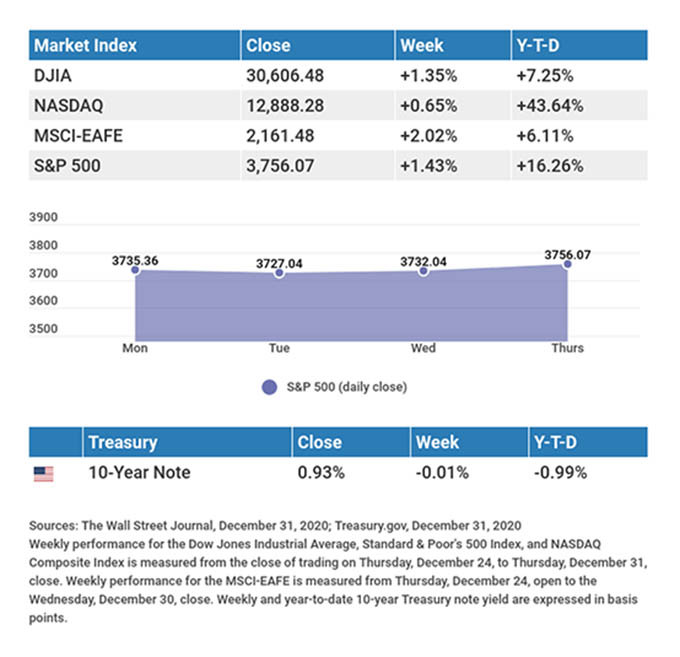
| A Note from Cokie: 2021 has started, and if you are an Alphavest client, you know exactly where and how your money is being invested. Remember this principle: The best time to get liberated and take control of your financial future is NOW! This is the perfect time to adopt and become motivated! You no longer have to be paralyzed by Wall Street’s games or overwhelmed with the idea of where to begin, restart or change your current investment portfolio. You can start today, right now, by investing with confidence. Call me for a free 15-minute consult and checkup! If you have NOT downloaded your copy of the third edition of The Liberated Investor, you can do that now so that you can understand the Wall Street game and play it better! Below is a weekly update and year-in-review from Wealth Enhancement & Preservation. The Week on Wall Street Stocks moved higher during a holiday-shortened week of trading, capping off a turbulent, but otherwise strong year for equity investors. The Dow Jones Industrial Average gained 1.35%, while the Standard & Poor’s 500 increased by 1.43%. The Nasdaq Composite index, which led all year, added 0.65%. The MSCI EAFE index, which tracks developed overseas stock markets, rose 2.02%.[1][2][3] The Year in Brief The global pandemic disrupted economies, financial markets, and daily life in 2020. Households and businesses were put to the test during the toughest and grimmest years in decades. The winter brought a resolution to the U.S.-China tariff dispute, the Brexit referendum, and the first U.S. appearance of the novel coronavirus. As spring started, abrupt stay-at-home orders in response to COVID-19 curtailed business activity, which dampened consumer spending. The federal government responded, arranging stimulus payments for millions of Americans. Wall Street bounced back from its March downturn, but the economy limped along. The pandemic entered its worst phase in fall, but two highly promising vaccines were announced in November, and as winter started, they began to roll out to the public. On the cusp of 2021, Congress approved a second national economic stimulus, and the European Union and United Kingdom signed off on a post-Brexit trade deal. There are many unanswered questions as we enter 2021. Will mass vaccination happen as quickly as we anticipate? Will a successful vaccination program lead to more hiring, more travel, more in-store shopping, and more confidence? The financial markets will be watching progress on this effort. The U.S. Economy The pandemic sent the U.S. economy into an abnormal phase, and so our fundamental economic indicators displayed atypical readings. The Department of Labor’s main jobless rate, 3.5% in February, hit 14.7% by April. Headline unemployment declined for the next seven months, to 6.7% by November. The U-6 unemployment rate, measuring unemployment and underemployment, peaked at 22.8% in April.[4][5] As people stayed home, consumer spending trended lower, falling 6.9% in March and 12.6% in April.[6] The federal government moved to boost economic activity. As March ended, a $2 trillion economic stimulus bill became law, featuring cash payments to households, temporary increases in federal unemployment benefits, and a Small Business Administration program pledging to offer distressed companies funds equivalent to 8 weeks of payroll costs. The aid began rolling out in April, and in May, the White House unveiled Operation Warp Speed, a public-private partnership intended to produce COVID-19 vaccines in record time. Two vaccines were approved by the Food and Drug Administration by fall.[7][8] The Federal Reserve took the benchmark federal funds interest rate down to a target range of 0-0.25%, and revived emergency loan programs first introduced in 2008. It collaborated with the Department of the Treasury on efforts to buy corporate bonds and encourage business loans. In a monetary policy shift, the central bank said in August that it would accept average inflation of 2% for the near term, and was willing to tolerate a little more inflation in the economy while pursuing the goal of full employment.[9][10] As stay-at-home orders lifted, the economy rebounded. Gross domestic product, which the Bureau of Economic Analysis said had contracted 31.4% in the second quarter, grew 33.4% in Q3. The BEA also recorded a 41.0% Q3 climb for consumer spending. Stay-at-home orders returned in Q4, however, prompting another federal economic stimulus in December.[11] The housing market stayed strong. By November, existing home sales were up 25.8% year-over-year, according to the National Association of Realtors; Census Bureau data showed a 20.8% annualized improvement for new home buying.[12][13] The U.S.-China tariff dispute eased throughout the year. In the January 2020 trade talks, the U.S. promised to lessen import taxes on Chinese goods, and China agreed to buy more American exports.[14] The Global Economy The International Monetary Fund expects the world economy will contract 4.4% in 2020. If that estimate holds, 2020 will be the worst year for global growth since the 1930s. The U.S. economy shrank 4.3% in 2020, according to the IMF’s forecast. That is better than the 8.3% setback estimated for the eurozone. The IMF projects that China’s economy grew 1.9% last year. As for 2021, it sees GDP advances of 8.2% for China, 5.2% for the eurozone, and 3.1% for the U.S.[15][16] The European Union and United Kingdom agreed to a post-Brexit trade deal on December 24. This completed the Brexit process, which began with the 2016 leave vote and included the U.K.’s formal exit from the E.U. last January. Businesses and financial firms based in the U.K. now face new trade rules and costs, even with the new pact in place.[17] Looking at stock benchmarks around the world, there were more ups than downs. South Korea’s Kospi Composite stood out with a 30.75% 2020 gain. Argentina’s MERVAL climbed 22.93%, Taiwan’s TWII 22.80%. Two other notable 2020 advances: Japan’s Nikkei 225 added 16.01%, and China’s Shanghai Composite rose 13.87%. There were also notable retreats: Indonesia’s IDX Composite lost 5.09%, France’s CAC 40 7.14%, Russia’s RTS 10.42%, and Spain’s IBEX 15.45%. The MSCI EAFE index, a broad benchmark tracking developed-economy stock market performance in Europe and Asia, rose 5.43%.[18][19] Final Thoughts We join all Americans in happily drawing the curtain on 2020. Though it was a challenging and tragic year for so many, there are good reasons to believe that 2021 will be a year of progress in returning to our pre-pandemic normal. We wish you and your family a healthy and happy new year! THIS WEEK: KEY ECONOMIC DATA Tuesday: Institute for Supply Management (ISM) Manufacturing PMI (Purchasing Managers Index). Wednesday: Automated Data Processing (ADP) Employment Change, Factory Orders. Thursday: Initial Jobless Claims, ISM Non-Manufacturing PMI. Friday: Employment Report. Source: Econoday, December 31, 2020The Econoday economic calendar lists upcoming U.S. economic data releases (including key economic indicators), Federal Reserve policy meetings, and speaking engagements of Federal Reserve officials. The content is developed from sources believed to be providing accurate information. The forecasts or forward-looking statements are based on assumptions and may not materialize. The forecasts also are subject to revision. THIS WEEK: COMPANIES REPORTING EARNINGS Thursday: Micron Technologies (MU), Constellation Brands (STZ), Walgreens Boots (WBA), Conagra Brands (CAG) Source: Zacks, December 31, 2020Companies mentioned are for informational purposes only. It should not be considered a solicitation for the purchase or sale of the securities. Investing involves risks, and investment decisions should be based on your own goals, time horizon, and tolerance for risk. The return and principal value of investments will fluctuate as market conditions change. When sold, investments may be worth more or less than their original cost. Companies may reschedule when they report earnings without notice. |

| [1] The Wall Street Journal, December 31, 2020 [2] The Wall Street Journal, December 31, 2020 [3] The Wall Street Journal, December 31, 2020 [4] Trading Economics, January 2, 2021 [5] CNN Business, May 8, 2020 [6] Investing.com, January 2, 2021 [7] Los Angeles Times, December 18, 2020 [8] Treasury.gov, January 2, 2021 [9] New York Times, December 23, 2020 [10] Reuters, August 27, 2020 [11] The Balance, December 27, 2020 [12] Reuters, December 22, 2020 [13] Census Bureau, December 23, 2020 [14] NPR, January 15, 2020 [15] Seattle Post-Intelligencer, December 31, 2020 [16] CNN Business, October 13, 2020 [17] The Week U.K., December 23, 2020 [18] Barchart.com, December 31, 2020 [19] Wall Street Journal, January 1, 2021 |